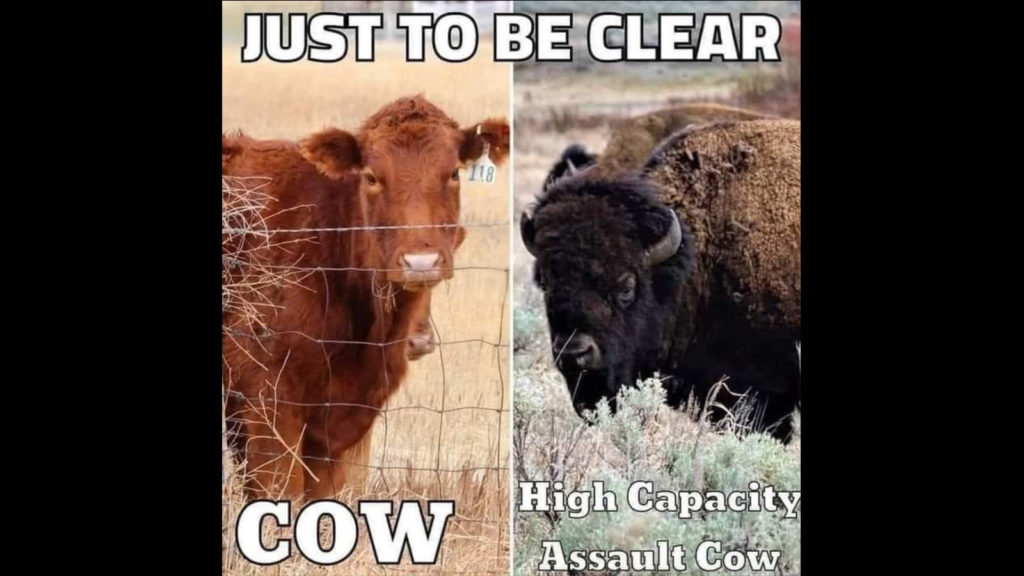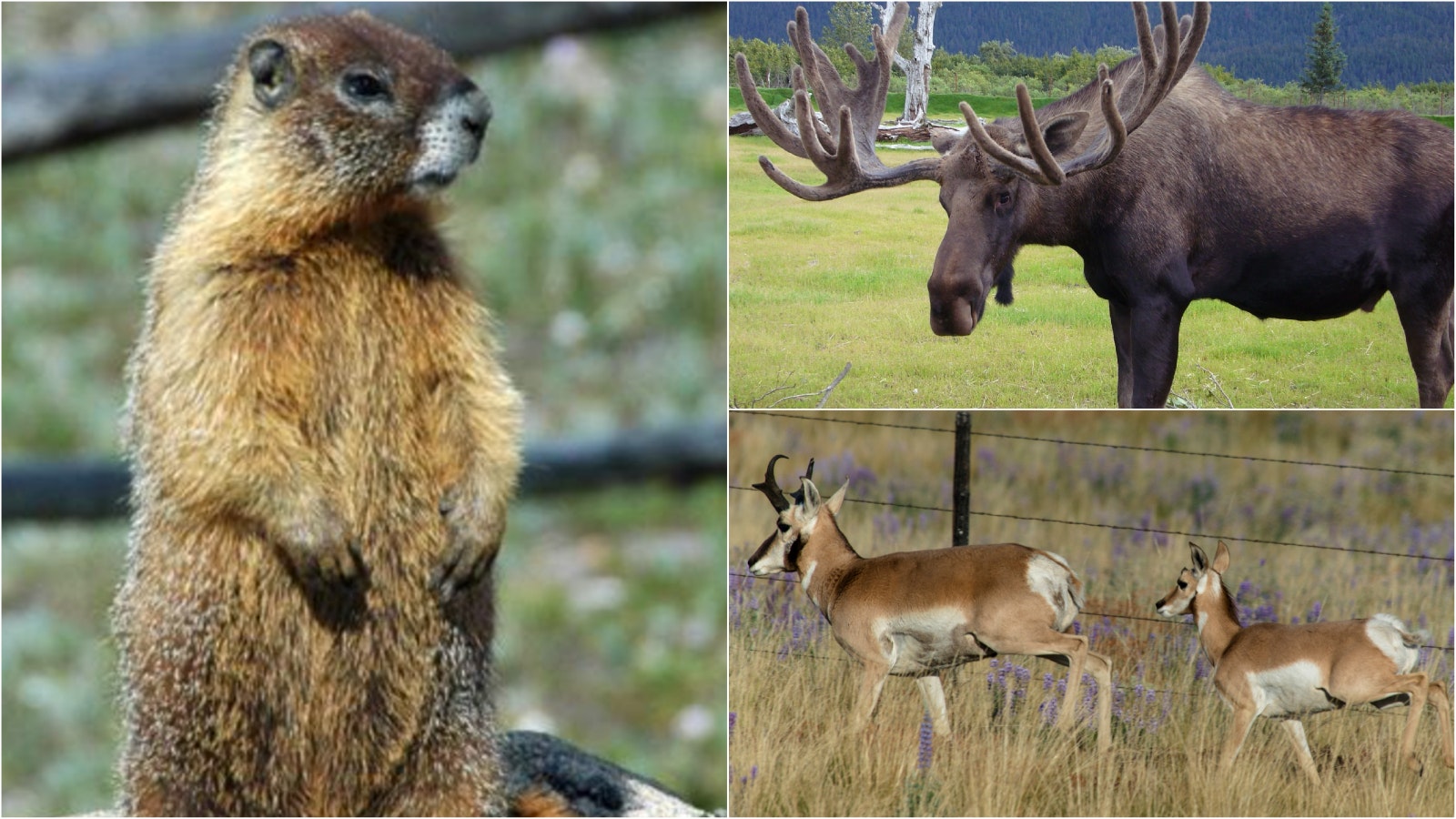A band of speed goats leaves a cloud of dust in their wake as they tear across the parched basin, while a swamp donkey enjoys greenery along a creek bed high on the slopes of nearby mountains.
Along a highway in a wooded valley on the other side of the mountains, intrusive tourists test the patience of assault cows. And from his perch in an alpine zone between the basin and valley, a whistle pig keeps diligent watch for predators near his den.
If they could grasp an understanding of those nicknames, the creatures pegged with them might be offended. Or amused. It’s impossible to say.
Formally, they go by the more dignified titles of pronghorn, Shrias Moose, American plains bison and yellow-bellied marmot. (OK, perhaps the “yellow-bellied” part isn’t so dignified).
Other animals, such as elk, might be misnamed, depending upon the perspective.
The Need For Speed (Goats)
Hang out around hunters long enough, and you’ll likely hear the animals commonly referred to as antelope being called “speed goats.”
So, are these animals members of the antelope family, or the goat family?
Trick question – they’re neither. They don’t belong to any family. At least none still living.
Pronghorn are a uniquely North American species. At one time in the distant past – probably even before the first humans arrived in what is now Wyoming – they had a few direct relatives. But those other species have since died out, leaving pronghorn as the sole survivors.
They’re built to survive. They have hollow hair which helps keep them cool during the blistering summers and warm during the frigid winters on their home range. Their vision is about as good as a human’s looking through a pair of 10-power binoculars.
And they’re arguably the fastest land animals on earth. African Cheetas can reach speeds of up to 70 miles per hour in short bursts – considerably faster than the pronghorn’s estimated top speed of about 55 mph. However, pronghorn can keep their top speed up for extended periods and across several miles. So, they would leave Cheetas in the dust in any race that lasted for more than a few seconds.
That, coupled with what could charitably be described as a goat-like face has led to perhaps their most popular nickname, “speed goats”.
“Antelope” is the most common informal name for them; even the Wyoming Game and Fish Department uses that title in its hunting regulations.
It’s speculated that when the first pioneers of European descent started to see the creatures as they pushed into the vast lands of the West, they didn’t know what to call them. Images of the various antelope species native to Africa probably came to mind, and the name stuck.
Large, Confusing Deer
“Swamp Donkey” is a fairly common colloquialism for moose, probably because of their awkward faces and huge, floppy ears.
Moose are the largest member of the deer family, which in Wyoming also includes whitetail and mule deer, as well as elk. (Well, moose might actually be elk, and elk might not be properly called elk after all – but more on that in a bit.)
The subspecies native to Wyoming is the Shiras Moose. They are smaller than Alaskan moose, but still impressively huge. And certainly nothing to trifle with. Moose are known to be generally fearless, and cow moose can become downright vicious if they sense a threat to their young.
The term “moose” is thought to have originated from “moosh”, which in the dialect of the Indigenous Canadian Innu people translates to “stripper and eater of bark,” according to the Encyclopedia Britannica’s online edition.
Except in Europe, they’re known as “elk”, and the European Cousins of what Americans call “elk” are “red deer.”
The European term “elk” probably traces back to old English and/or German words meaning “large deer,” according to Britannica. Which is why swamp donkeys … err, moose, are called elk on that side of the pond.
Meanwhile, the creatures known to Indigenous Americans as “Wapiti” are called “elk” over here. Probably, again, because European explorers called them “elk” upon first encountering them, because that was their old term for “large deer.” Which is what they are.
Who You Calling “Whistle Pig”?
Yellow-bellied marmots are frequently called “rock chucks,” at least in this region. Although they go by a variety of nicknames. They might occasionally be called “whistle pigs” in Wyoming, but that term seems to be more commonly used in the South for ground hogs.
Wyoming’s marmots are sometimes also called “ground hogs”, even though they aren’t. Marmots, which populate the Western states, and ground hogs, which are found in the East and South, are closely related, but not the same species. They are among the largest members of the squirrel family.
The term “chuck” is frequently attached to both critters, as in “rock chuck” or “wood chuck.” That’s probably because of a the “chucking” sound of their alarm calls, according to the Marmot Burrow web site and University of California biologist Daniel T. Blumstein.
“Assault Cows”
And lastly, we come to buffalo … no, wait, bison.
These massive, iconic creatures are most properly called American plains bison. They are related to the American wood bison, which has a more northern, forested home range.
They aren’t related to actual buffalo, which include Asian water buffalo and African cape buffalo.
As to how they came to be called buffalo, it seems that confused European explorers are again to blame.
“The word buffalo is derived from the French “bœuf,” a name given to bison when French fur trappers working in the U.S. in the early 1600s saw the animals,” says information posted online by the National Park Service. “The word bœuf came from what the French knew as true buffalo, animals living in Africa and Asia. Although this name was a mix-up of two different animals, many people still know bison as buffalo today.”
The online site “Yellowstone: Invasion of the Idiots,” founded by two Yellowstone-area residents to chronicle the misadventures of tourists, features a far better nickname. It’s based upon the bison sometimes losing patience and hammering foolhardy tourists who have invaded the bison’s personal space: “High capacity assault cow.”






